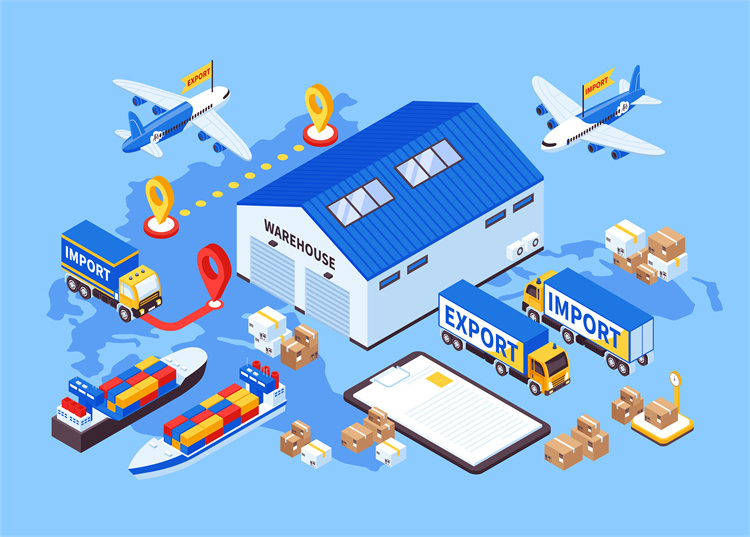The Supply Chain: From Raw Materials to Order Fulfillment

The supply chain acts as the lifeline of modern business, connecting raw materials to finished products. This intricate network involves sourcing, production, and delivery, ensuring goods reach consumers efficiently. Each step in the supply chain holds significance, impacting cost, quality, and speed. Businesses thrive by mastering this process, achieving operational excellence and customer satisfaction. Understanding the journey from raw materials to order fulfillment reveals the art of transforming resources into value, a dance of logistics and strategy that defines success in today's competitive market.
Understanding the Supply Chain
Definition and Components
The supply chain resembles a grand orchestra, where each section plays a vital role in creating a harmonious symphony. The journey begins with raw materials, the building blocks of every product. These materials come from nature or are manufactured by other industries. Producers extract or create them, setting the stage for the next act.
Raw Materials
Raw materials form the foundation of any product. Miners dig deep to unearth precious metals. Farmers cultivate crops with care. Chemists synthesize compounds in laboratories. Each source provides essential ingredients for production. Without raw materials, the show cannot go on.
Production
Production transforms raw materials into finished goods. Factories buzz with activity as machines hum and workers assemble components. Engineers design processes to maximize efficiency. Quality control teams ensure that products meet high standards. Production breathes life into raw materials, turning them into something valuable.
Distribution
Distribution acts as the bridge between production and retail. Trucks rumble down highways, planes soar through skies, and ships navigate oceans. Logistics teams coordinate these movements with precision. Warehouses store products until they reach their final destinations. Distribution ensures that goods travel safely and swiftly.
Retail
Retail serves as the grand finale of the supply chain. Stores display products on shelves, enticing customers with vibrant packaging. Sales associates assist shoppers in finding what they need. Online platforms offer convenience with just a click. Retail connects products to consumers, completing the supply chain journey.
Key Players in the Supply Chain
In the world of supply chains, key players take center stage, each contributing to the performance. Suppliers, manufacturers, distributors, and retailers work together to ensure a seamless flow of goods.
Suppliers
Suppliers provide the raw materials needed for production. They negotiate contracts, manage costs, and maintain a steady supply. Reliable suppliers keep the supply chain running smoothly. Businesses depend on them to deliver quality materials on time.
Manufacturers
Manufacturers transform raw materials into finished products. They oversee the production process, ensuring efficiency and quality. Skilled workers and advanced machinery bring designs to life. Manufacturers play a crucial role in meeting consumer demands.
Distributors
Distributors handle the logistics of moving products from manufacturers to retailers. They manage transportation, warehousing, and inventory. Effective distribution requires coordination and precision. Distributors ensure that products reach their destinations without delay.
Retailers
Retailers connect products to consumers. They create appealing displays and offer personalized service. Retailers understand consumer preferences and adjust their offerings accordingly. They complete the supply chain by delivering products to the end-users.
Phases of the Supply Chain
The supply chain unfolds in distinct phases, each contributing to the seamless journey from raw materials to finished products. Understanding these phases reveals the strategic choreography behind every successful business operation.
Planning
Planning serves as the foundation of an efficient supply chain. Businesses must anticipate demand and manage inventory to ensure smooth operations.
Demand Forecasting
Demand forecasting predicts future consumer needs. Analysts study market trends and historical data to make informed predictions. Accurate forecasts prevent overproduction and stockouts. Businesses gain a competitive edge by aligning production with demand.
Inventory Management
Inventory management involves maintaining optimal stock levels. Managers track inventory to prevent excess or shortage. Efficient systems reduce holding costs and improve cash flow. Businesses achieve flexibility by adapting to changing market conditions.
Sourcing
Sourcing focuses on acquiring the necessary materials and services. Effective sourcing strategies enhance the supply chain's resilience and efficiency.
Supplier Selection
Supplier selection identifies reliable partners for material procurement. Companies evaluate suppliers based on quality, cost, and reliability. Strong supplier relationships ensure a steady flow of materials. Businesses mitigate risks by choosing dependable partners.
Procurement Process
The procurement process involves acquiring goods and services. Procurement teams negotiate contracts and manage supplier relationships. Streamlined processes reduce costs and improve efficiency. Businesses benefit from timely deliveries and quality materials.
Manufacturing
Manufacturing transforms raw materials into finished products. This phase requires precision and coordination to meet consumer expectations.
Production Scheduling
Production scheduling organizes manufacturing activities. Planners allocate resources and set timelines to optimize output. Efficient schedules minimize downtime and maximize productivity. Businesses meet deadlines by adhering to well-structured plans.
Quality Control
Quality control ensures products meet standards. Inspectors monitor production to identify defects and maintain quality. Rigorous testing guarantees customer satisfaction. Businesses build trust by delivering reliable products.
Delivery
Logistics
Logistics orchestrates the grand ballet of moving products. Trucks, ships, and planes dance across continents, ensuring timely deliveries. Logistics teams choreograph each step with precision. Every movement counts in this intricate performance. Efficient logistics reduce costs and enhance customer satisfaction. A well-tuned logistics system provides a competitive edge.
Scientific Research Findings:
Efficient supply chain management leads to cost reduction and improved efficiency.
Logistics plays a crucial role in maintaining volume flexibility and financial health.
Order Fulfillment
Order fulfillment concludes the supply chain journey. Warehouses buzz with activity as workers prepare packages. Robots and humans work side by side, picking and packing products. Each order receives careful attention to ensure accuracy. Fast and reliable order fulfillment delights customers. Happy customers return for more, boosting profits.
Scientific Research Findings:
Effective supply chain management improves procurement processes and mitigates risks.
Order fulfillment enhances customer satisfaction and operational efficiency.
Supply Chain Models

The world of supply chains dances to the rhythm of different models. Each model has its own tempo and style. Businesses choose models based on their unique needs and goals.
Push vs. Pull Models
The push and pull models represent two distinct approaches to managing supply chains. Each model offers its own set of characteristics and benefits.
Characteristics of Push Model
The push model operates like a well-rehearsed orchestra. Businesses forecast demand and produce goods in advance. Warehouses fill with products waiting for customers. This model suits industries with stable demand patterns. Companies enjoy economies of scale by producing large quantities. The push model reduces production costs and ensures product availability. However, excess inventory can lead to increased holding costs.
Characteristics of Pull Model
The pull model resembles an improvisational jazz band. Production begins only after receiving customer orders. This approach minimizes inventory levels and reduces waste. Businesses respond quickly to changing consumer preferences. The pull model enhances flexibility and reduces storage costs. Companies avoid overproduction and adapt to market fluctuations. However, longer lead times may affect customer satisfaction.
Hybrid Models
Hybrid models blend elements of both push and pull strategies. These models offer a balanced approach to supply chain management.
Benefits of Hybrid Models
Hybrid models provide the best of both worlds. Businesses enjoy the stability of push models and the adaptability of pull models. These models optimize inventory levels and reduce waste. Companies achieve cost savings and improved customer satisfaction. Hybrid models enhance supply chain resilience and efficiency. Businesses respond effectively to market changes and consumer demands.
Examples of Hybrid Models
Many industries embrace hybrid models to meet their unique needs. E-commerce logistics exemplifies the integration of push and pull strategies. Companies automate processes to improve efficiency. Integrated systems connect all steps in logistics seamlessly. E-commerce businesses enhance connectivity and streamline operations. Automation reduces errors and speeds up order fulfillment. Hybrid models empower companies to thrive in competitive markets.
Importance of the Supply Chain
The supply chain holds immense significance in modern business. It impacts various aspects, from economic factors to ethical considerations and career opportunities.
Economic Impact
The supply chain serves as a powerful engine driving economic growth. Businesses leverage efficient supply chains to achieve remarkable cost efficiency and market reach.
Cost Efficiency
Cost efficiency emerges as a vital benefit of a well-managed supply chain. Companies optimize their operations by reducing waste and minimizing unnecessary expenses. Streamlined processes lead to lower production costs. Businesses pass these savings on to consumers, resulting in competitive pricing. The global supply chain evolution in the 1930s and 1940s exemplifies how sourcing materials from different countries brought down prices for consumers.
Market Reach
Market reach expands significantly through effective supply chain management. Companies access new markets and reach a broader audience. Efficient distribution networks ensure products are available worldwide. Businesses capitalize on opportunities to serve diverse customer bases. The supply chain's integral role in company growth and success across industries highlights its impact on market reach.
Ethical Considerations
Ethical considerations play a crucial role in shaping supply chain practices. Companies prioritize sustainable sourcing and fair labor practices to align with societal values.
Sustainable Sourcing
Sustainable sourcing focuses on responsible procurement of materials. Companies choose suppliers who adhere to environmental standards. This approach minimizes ecological impact and promotes resource conservation. Businesses enhance their reputation by demonstrating commitment to sustainability. Consumers appreciate products that reflect ethical sourcing practices.
Fair Labor Practices
Fair labor practices ensure workers' rights and well-being. Companies collaborate with suppliers who uphold fair wages and safe working conditions. Ethical supply chains promote social responsibility and human rights. Businesses build trust with consumers by prioritizing worker welfare. Fair labor practices contribute to a positive brand image and customer loyalty.
Career Opportunities
The supply chain offers diverse career opportunities for individuals seeking dynamic roles. Professionals find rewarding positions in supply chain management, contributing to business success.
Roles in Supply Chain Management
Roles in supply chain management encompass various functions. Professionals work as logistics coordinators, procurement specialists, and inventory managers. Each role plays a vital part in ensuring smooth operations. Companies rely on skilled individuals to optimize supply chain processes. These roles offer opportunities for growth and advancement.
Skills Required
Skills required for supply chain management include analytical thinking and problem-solving. Professionals must possess strong communication and negotiation abilities. Attention to detail and adaptability are essential traits. Companies value individuals who can navigate complex supply chain challenges. These skills empower professionals to excel in their roles and drive business success.
The journey from raw materials to order fulfillment showcases a mesmerizing dance of logistics and strategy. Supply chains play a pivotal role in business success, acting as the backbone that supports operational excellence and customer satisfaction. Mastery of supply chain management transforms resources into value, creating a competitive edge in the market. Exploring supply chain management as a career path offers exciting opportunities for individuals seeking dynamic roles. The field promises growth and advancement for those who embrace its challenges and rewards.
See Also
Uncovering Robotics Innovation: Supply Chain Transformation
Artificial Intelligence Logistics: Transforming Future Supply Chains
The Impact of Cloud Solutions on Industry Supply Chains
Addressing Global Expansion Challenges in Supply Chain Management
